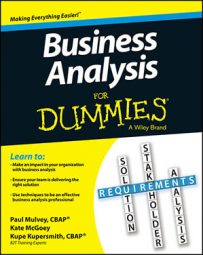Requirements workshops, also known as JAD sessions, facilitated workshops, or work sessions, are well-structured, intensive workshops in which an independent facilitator (the business analyst) leads participants to develop high-quality work requirements (or products).
The requirements workshop is one of the best techniques to use if you want high-quality requirements in a short amount of time. You can use these workshops at any stage in the project whenever you need to pull in a lot of brainpower from the project team.
The products a requirements workshop produces are high quality because many people participate in the session, and the solution comes from the synergy created by everyone working together. (Synergy is the idea that the sum of everyone’s contribution is greater than any individual part.) Different people bring different suggestions to the table and ask different questions as they come up with solutions.
How to identify participants for a business analysis requirements workshop
Requirements workshops can range from one to many hours. You may need multiple sessions over a period of a few days. Because these workshops generally require a significant amount of time, considering who should attend is important. The attendees fall into three categories:
Required attendees: These folks are the people who the meeting can’t go on without. If these people don’t show up, the meeting can’t be successful, and you end up with a lot of out-of-meeting tasks.
Optional attendees: The meeting can still go on and be successful without these people. However, having them in the session can be helpful because they may bring valuable insight and opinions.
Other people: These attendees may be new team members who have just joined the team and are there to listen to how the topic being discussed works. Perhaps you’re cross-training them or interfacing with them from another business domain.
How to schedule a business analysis requirements workshop
When you schedule, you have to look at several factors — the availability of your required attendees, their location, and the length of time you need them. When, where, and for how long you have a workshop depends on knowing this information. Some questions to ask to get the answers include the following:
Who are the required attendees, and what is their availability?
Where are the attendees located? Are they all in the same building? Different locations? Different time zones? The answers to these questions determine whether you have an in-person or virtual workshop. If attendees are in multiple time zones all over the world, for example, you need to hold a virtual meeting.
How long do I make the workshop? This determination depends on how much information you have to cover and on the limitations of stakeholder engagement. If you’re physically in a meeting room together, you can easily monitor the engagement level of the attendees. If you’re holding an online or phone conference, expect that people more easily multitask and may not stay 100 percent engaged.
To combat that tendency, keep virtual meeting durations short (one hour or less) so people don’t feel the meeting is taking away from their day.
When planning your workshop, look at people’s calendars and make sure they’re available to attend. State which if any attendees are required. If those people don’t show for the meeting, cancel it; having the meeting without them is a waste of time because you’ll only have to have a second meeting when they do attend.
If it becomes common that required attendees do not attend meetings, consider two things. First, ask yourself whether you have the right people identified. Second, determine whether the need to reschedule meetings is putting the project at risk. If the project is at risk, make sure to share that exposure with the team.

